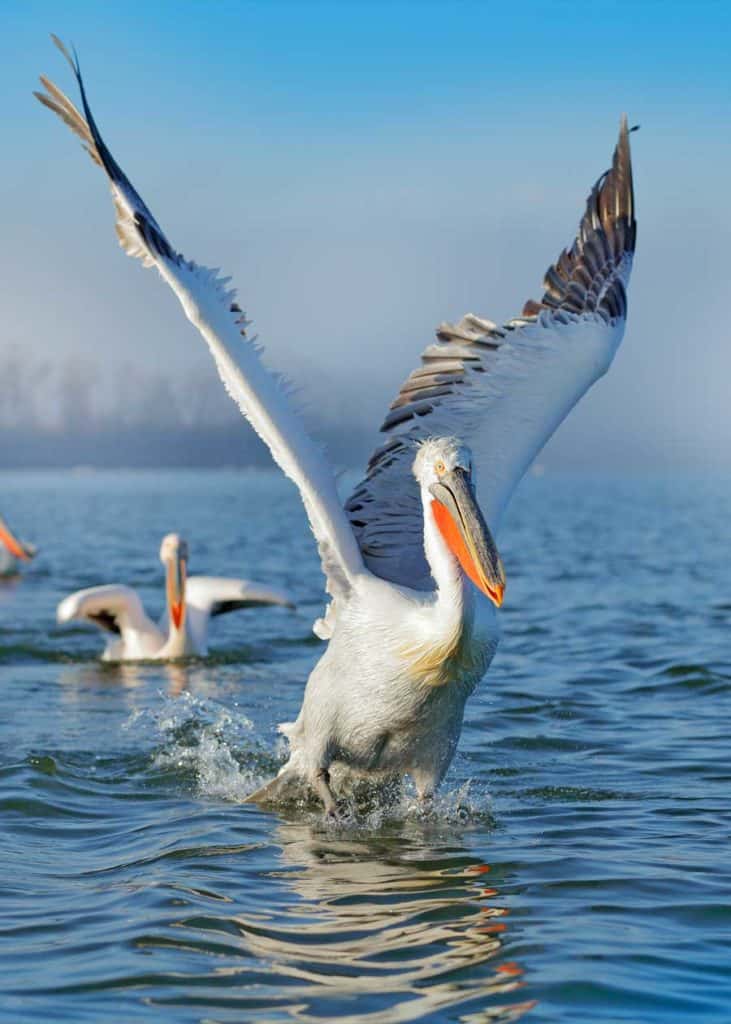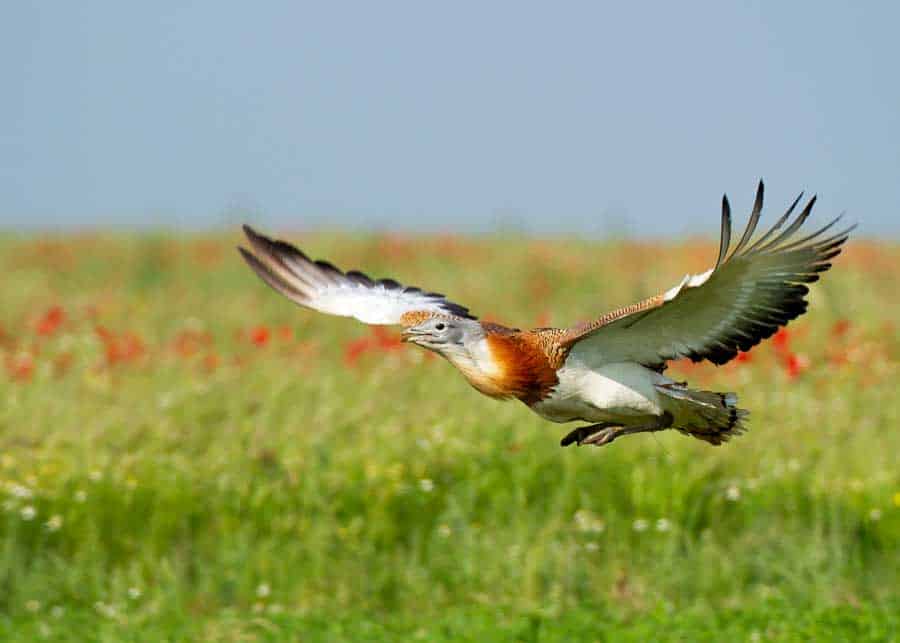9 Biggest Birds That Fly: World’s Largest by Wingspan and Weight
Birds are some of the most majestic creatures on earth and they come in varying sizes and shapes. Which are the biggest birds that fly? Here are the largest birds in the world by wingspan and weight.
The largest flying bird in the world by wingspan is the wandering albatross. This enormous bird has a wingspan that extends up to 12 feet in length, larger than any other living bird. However, the largest flying bird in the world by weight is the great bustard, which weighs up to 40 pounds.

Those are some pretty large wingspans, aren’t they? If you would like to know more about big birds, read on. Included below is a list of some of the largest birds (by wingspan) in the world!
Largest Birds in the World
1. Wandering Albatross (Largest Wingspan)
- Scientific name: Diomedea exulans
- Also known as snowy albatross, white-winged albatross, and goonie
- Weight: 19 lb (8.4 kg) average. Range of 14.0 to 26.3 lb (6.35 to 11.91 kg)
- Wingspan: 12 ft 2 in (3.7 m) is the longest-winged verified example. The mean wingspan is 10 ft 2 in (3.1 m).

The wandering albatross wins first place for the largest bird with a gigantic wingspan of up to 12 feet.
While its wingspan is huge, however, the wandering albatross is not the heaviest bird in the world. It only weighs in at about 14-26 pounds. The wandering albatross is native to several parts of the Southern Hemisphere. It lives mostly out at sea and, as a matter of fact, only returns to land once every two years to breed.
Thanks to this albatross’s fantastic wingspan, this legendary flier can fly up to 600 miles a day. This distance would be equivalent to 18 round trips to the moon throughout their lifetimes.
Unfortunately, albatrosses are beginning to dwindle in numbers with only about 25,000-26,000 adult birds left in the wild.
Learn about the waved albatross – the largest bird in the Galapagos. They have an 8-foot wingspan.
2. Dalmatian Pelican
- Scientific name: Pelecanus crispus
- Weight: 25 lb (11.5 kg)
- Wingspan: 8 to 11.5 ft (245 to 351 cm)

The Dalmatian pelican can weigh as much as 33 pounds and has a potential wingspan of 8 feet to 11.5 feet. Some bustards and swans can be bigger than this pelican, but that is usually a rare occurrence.
Dalmatian pelicans can breed all throughout southeastern Europe and in several parts of Asia.
The Dalmatian pelican is actually the largest member of the pelican family. Like most other species of pelican, the Dalmatian pelican population has greatly declined over the years.
3. Andean Condor (Largest Bird of Prey)
- Scientific name: Vultur gryphus
- Weight: 25 lb (11.3 kg)
- Wingspan: 10 ft 10 in (3.3 m) maximum wingspan

The Andean Condor can make its mark both in the weight and wingspan department. It weighs up to 33 pounds (which is only nine pounds short of the great bustard) and has a wingspan of 8 feet 10 inches to 10 feet 10 inches.
The Andean condor wins the prize for the largest bird of prey in the world.
As you have probably figured out, Andean condors are native to the Andes Mountains in South America. Sometimes they can even appear near deserts and coasts in that region as well.
The species had made its way onto the endangered species list at one time, but through vigilant conservation efforts, the population has made a bit of a comeback.
4. Eurasian Black Vulture
- Scientific name: Aegypius monachus
- Also known as black vulture, monk vulture, and Eurasian black vulture
- Weight: 21.1 lb (9.55 kg) median weight
- Wingspan: 8 ft 2 in – 10 ft 2 in (2.5–3.1 m)

Vultures are not generally considered to be the prettiest birds in the world, but the Eurasian Black Vulture definitely makes a statement in the large bird department.
Also known as the black vulture, cinereous vulture, and monk vulture, the Eurasian black vulture has a wingspan of anywhere from 8 to 10 feet. It can weigh anywhere from 14-31 pounds, and unlike most bird species, the females are actually larger than the males.
As the name suggests, Eurasian black vultures are most commonly found in parts of Europe and parts of Asia. Like the Dalmatian pelican, the Eurasian black vulture population is steadily decreasing. It has made a place for itself on the nearly endangered species list.
5. Shoebill
- Scientific name: Balaeniceps rex
- Also known as shoebill stork, whalehead, whale-headed stork, and whalebill
- Weight: Males weigh an average of 12 lb (5.6 kg) and females 11 lb (4.9 kg)
- Wingspan: 7.5 to 8.5 ft (230 to 260 cm)

The shoebill is a large, stork-like bird, but is no longer classified in the stork Ciconiiformes order. It appears to be more genetically similar to herons and pelicans.
Shoebills have a wingspan of about 8 feet wide. And can weigh 11 to 12 lbs.
It lives in swamps of tropical east Africa, feeding on fish. They often benefit from hippo activity, as fish surface as submerged hippos pass by.
6. Trumpeter Swan (Largest North American Bird)
- Scientific name: Cygnus buccinator
- Weight: 15 to 30 lb (7 to 13.6 kg)
- Wingspan: 6 ft to 8 ft 2 in (185 to 250 cm)

Most swans are fairly large and the trumpeter swan is no exception to this. With a 6 to 8-foot wingspan and weight range of 15 to 30 pounds, the trumpeter swan is actually the heaviest living bird native to North America.
The largest trumpeter swan on record had a wingspan of 10 ft 2 in (3.1 m) and a weight of 38 lb (17.2 kg), which is non-typical.
They used to be nested all over North America, though their numbers have severely dwindled over the years with the arrival of people settling all over the continent.
Trumpeter swans can be found primarily in Canada, Alaska, and several parts of the northwestern United States. Since trumpeter swans are so large (both wingspan-wise and weight-wise) they usually require 300+ feet of space to take off.
7. Kori Bustard
- Scientific name: Ardeotis kori
- Weight: 15 to 40 lb (7 to 18 kg)
- Wingspan: 7.5 ft to 9 ft (230 to 275 cm)

The bustards are some of the heaviest birds in the world. The kori bustard is second only to the great bustard in the weight department with a range of 11-40 pounds.
It only has a wingspan of 7-9 feet but it is definitely one of the heaviest birds out there.
These birds are native to South Africa, and although they are technically flying birds, kori bustards are heavy enough that they prefer to dwell on the ground. They tend to only fly when they feel threatened or are in serious danger.
Some individuals have significantly exceeded the average weight. There are reports of individual kori bustards weight 51 lb (23 kg), 75 lb (34 kg), and even 88 lb (40 kg). It’s important to note that the size of these oversized bustards hasn’t been verified.
8. Whooper Swan
- Scientific name: Cygnus cygnus
- Also known as the common swan
- Weight: 16 to 30 lb (7.4 to 14 kg)
- Wingspan: 6.75 to 9 ft (205–275 cm)

Just like its cousin (the trumpeter swan), the whooper swan is a large bird. It has a wingspan range of 6-9 feet and a weight range of 16-30 pounds.
These swans can usually be found in parts of eastern Asia and parts of southern Europe, though they have been known to migrate as far as western Alaska.
Whooper swans will also travel to the UK from Iceland to nest in wetlands and estuaries during the winter months. Like the albatross, whooper swans can fly hundreds of miles in one day. When they fly from the UK to Iceland and vice versa, they don’t stop until they get there.
In the spring, whooper swans will fly, non-stop, from Scotland to Iceland. During this migration, they travel at very high altitudes; indeed, a pilot flying at 8,000 feet once reported seeing a flock of swans that were thought to be whoopers.
Wildlife Trusts
9. Great Bustard
- Scientific name: Otis tarda
- Weight: 13 to 40 lb (5.8 to 18 kg)
- Wingspan: 7 ft to 8 ft 10 in (2.1–2.7 m)

At long last, we have come to the king of heavy flying birds, the great bustard. This bird, while only having a wingspan of 7-10 feet, can weigh as much as a whopping 44 pounds.
The males are pretty massive, and the females are slightly smaller. The largest recorded great bustard was 46 pounds.
Great bustards are native to Europe with a vaguely familiar subspecies dwelling in Asia. Unfortunately, like many other birds on this list, the great bustard’s numbers are dwindling as well.
Other Large Birds
Other large birds (non-flying) include ostriches, cassowary, rhea, and the emperor penguin. Did you know that ostriches are one of the fastest animals in Africa?
Learn more about big birds: 9 Largest Eagles in the World

Keep reading: 9 Ugly African Animals to See on Safari
Your Turn
Have you seen any of these large birds in the wild? What is the largest bird that you’ve seen? I would love to hear your experiences below.






